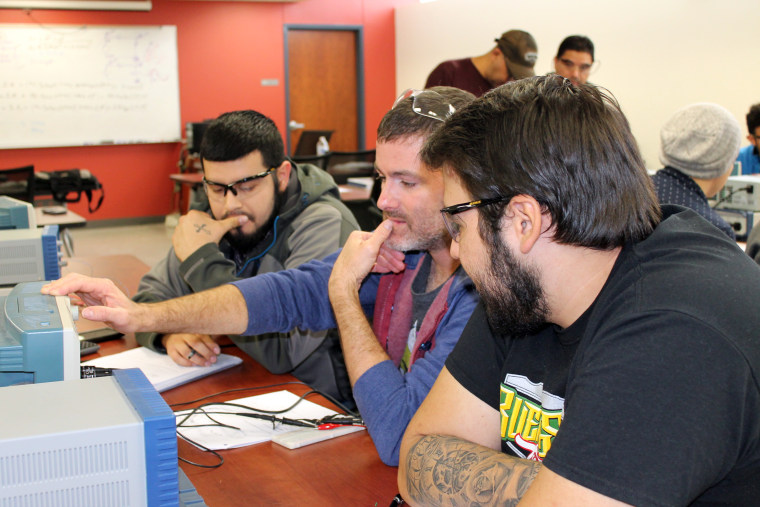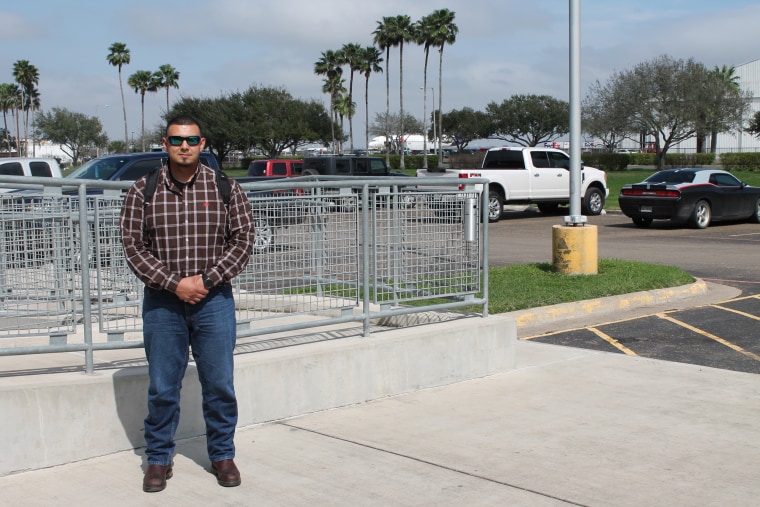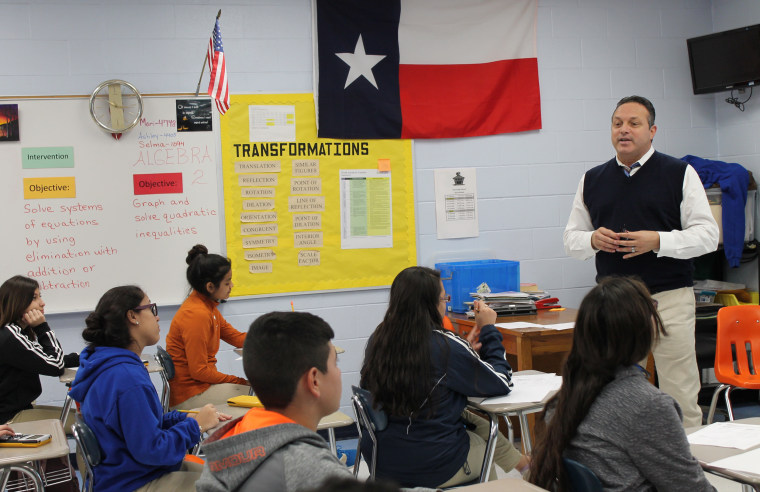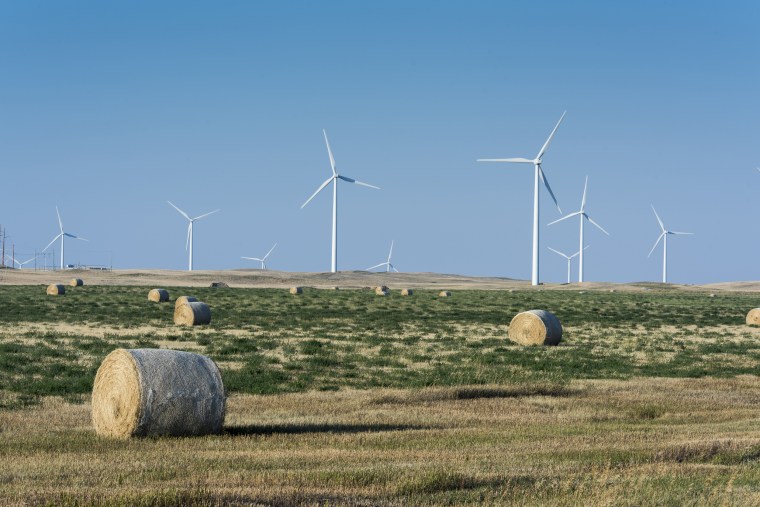Editor’s note: This story is the third in the Map to the Middle Class series from The Hechinger Report, examining how schools can prepare students for the good middle-class jobs of the future. The piece has been jointly published by NBCNews.com and The Hechinger Report, a nonprofit, independent news organization focused on inequality and innovation in education.
BRUNI, Texas — The town of Bruni in southwest Texas is just a speck on the map in an area surrounded by miles of mesquite trees, cows and not much else. Since the oil wells slowed down, the biggest economic engines in this no-stoplight town are the county school district, which serves about 300 kids, and a row of makeshift casinos run out of dilapidated houses lining the highway.
And the wind. It barrels across the plains to power glistening white turbines dotting the horizon whichever way you look. More turbines are being built next year — and when they come, the schools here will be ready for them.
The Webb Consolidated Independent School District, which serves Bruni and a handful of other tiny towns, is launching what might be the nation’s first wind turbine technician program for high school students. Starting next year, students at Bruni High School will be able to take coursework that will give them a jump start on an associate degree in wind, which they can finish at Texas State Technical College in Harlingen, two and half hours down the road. The students can even earn a certificate through the classes and go straight to work on the turbines.

Locals hope the program will make this little school district a national model. “We have very poor children who come from poor families,” said Robert Marshall, Webb’s school board president and a rancher who owns a construction business that services the oil fields. For many students, he said, “none of the family have ever gone to college.”
“We’re giving them opportunities,” he said.
Politicians may hotly debate climate change and what to do about it, but the economy has come down clearly on one side. Jobs in clean energy are growing faster than any other sector in the United States. At the top of the list is solar panel installer, a position that typically requires just a high school diploma and pays close to $40,000 a year. Wind turbine service technician, with a solidly middle-class salary of $52,000 on average, comes in second. The position requires technical school training.
Industry experts say wind technicians, in particular, often earn a lot more. In the Webb school district, for instance, Marshall has made tax abatement deals with local wind companies that set aside a certain number of jobs for local residents, with a minimum entry-level salary requirement of $46,000. With overtime, workers can earn as much as $70,000, even $90,000, after a couple of years, Marshall said. The median salary in Bruni is about $50,000, but about 30 percent of the town’s 281 residents -- and more than half of its children -- live below the poverty line.
Perhaps the best part about wind jobs, industry experts say, is that they’re inherently rural, meaning they provide stable middle-class jobs in places that often have few other industries. Lower living costs in rural areas mean these salaries can stretch further, said Hannah Hunt, a senior analyst at the American Wind Energy Association, a trade association for the wind industry.
“Ninety-nine percent of wind projects are in rural areas,” she said, “and over 70 percent of the installed capacity is installed in low-income counties.”
Many of the nation’s wind installations are appearing in places that have lost manufacturing jobs. Harlingen in the Rio Grande Valley is a case in point. In the 1990s, the region lost a host of factories as companies moved across the river to Mexico for the cheaper labor. Some manufacturing and oil jobs remain, but nearly a third of residents live below the poverty line and the unemployment rate is 6 percent, higher than the national average.
Now, students from the Rio Grande Valley are flocking to a program that trains them to climb and fix 40-foot-high wind turbines sprinkled across the region’s ranchland and coast. Texas State Technical College students can earn a certificate as a wind energy technician in a year for about $6,000, or they can stay for two years to earn an associate degree in wind energy technology for about $10,000. The jobs can pay a lot better than many manufacturing jobs, and all graduates get hired, said David Sanchez, the lead instructor for the college’s wind, telecommunications and biomedical program.
“The college is trying to beat the curve,” Sanchez said. “We’re trying to train students before the demand is out there at 100 percent.”
RELATED: Jobs in cybersecurity are exploding: Why are women locked out?
Sanchez said wind jobs require fewer years of training than well-paying health care jobs like nursing, also a ballooning industry here, and often pay better than jobs that require a four-year degree, like teaching.
Still, the work isn’t easy.
On a recent morning at 8 a.m., several burly young men in hoodies, one toting a motorcycle helmet, were studying their textbooks before instructor Braulio Gonzalez’s AC-DC class in electronics. “Do you think we need to know the angles?” one wondered. “I hope not,” the others muttered.
Yes, it turned out, they need to know the angles. For an hour, Gonzalez drew equations and diagrams on the board, explaining how using the Pythagorean theorem and trigonometry to convert angles from a rectangular coordinate system to a phasor coordinate system would help them check their work in the field.
“I was thinking it was going to be a lot easier. I had to slap myself in the face,” said Crescencio Cruz, 36, a former Marine who did two tours in Iraq.

The program is a mix of adults switching careers and young people, a few years out of high school, getting serious about their studies. Cruz worked in the oil fields for GE Oil & Gas until the overtime hours started drying up. “We were getting paid good money,” he said. “But a lot of people were getting laid off, and I worried I’d be next.”
Cruz said some of the wind turbine work is similar to servicing pump units for the oil company. But a solid grip of college algebra and trigonometry is essential to understand the turbine machinery. Cruz along with several of his peers have made use of the college’s tutors to keep up.
During the second half of class, students moved to the back of the room and gathered in small groups around several oscilloscopes, which display oscillations in electrical current. Gardiel Martinez, 25, tried to get the waves on his screen to look like the ones Gonzalez had drawn on the board. Before coming to the college, Martinez served in the Navy, then as a corrections officer at a maximum-security prison three hours from his home. But with two preschool-age daughters, he said he didn’t want to be stuck “just being in the Valley and getting a minimum-wage job and not really moving forward.”
After several friends graduated from Texas State’s wind program and went on to get well-paying jobs, he signed up, and plans, literally, to climb his way up a wind turbine to the middle class.
His mother has a certificate and works in accounting, and his father is a hydraulics mechanic. “That’s the end goal, at least what my parents drilled into me,” said Martinez, who is the first in his family to go to college. “To do better than whatever they’re doing now.”
The program doesn’t just test students’ math skills, it also tests their physical and psychological fitness for the job. They can’t be afraid of heights, for one. And while more wind turbines are being outfitted with elevators, climbing daily on the vast majority of turbines that still lack them is hard on the knees — even with powered climb assists taking some of the weight off as workers ascend the ladders.
RELATED: Can educating kids about unions prepare them for the future of work?
Industry experts say that physically demanding technician jobs are only one slice of a growing industry, however. The nation’s more than 52,000 wind turbines in 41 states and territories have helped generate a total of 102,500 jobs so far, according to a 2017 industry report. Projects need engineers, construction workers, control room operators, site supervisors and environmental assessors, among other positions. Analysts like Hunt say that even in places where there aren’t any turbines, most notably in sultry Deep South states, factories are cropping up to manufacture parts for the industry. And some older factories have diversified “because they believe it’s a smart investment,” Hunt said.
At NextEra Energy, a renewable energy company, communications manager Bryan Garner said it’s common for wind technicians to move up into site and project management positions. While these jobs typically require a bachelor’s degree, he said the company often helps its employees with tuition. “There have been some great success stories,” he said.
In Harlingen, David Sanchez said he hasn’t had to put much effort into recruiting students — the wind turbines themselves are the perfect billboard — although he sometimes takes a flatbed truck mounted with a model turbine out to high school career fairs. But elsewhere in the country, educators are trying to entice high school students to start thinking about wind (and studying their trig) before they get their diploma, especially in rural areas where entering the middle class so often means leaving home.
Oklahoma is famous for its gusting winds, yet the industry is still nascent there. But interest is growing, according to Kathy Jackson, founder of SpiritWind, an educational organization in Oklahoma City. She travels the state talking about wind to students and teachers at schools where local career options are “either farming or farming.”
“This changes the ballgame,” Jackson, who also still works as an oil landman, said of the wind industry. “It makes a more level playing field for kids in those rural communities.”

That’s what Webb superintendent Beto Gonzalez in Bruni is banking on. Wind companies, including NextEra Energy, have helped the district set up three immaculate classrooms alongside the pigpens in the district’s agricultural science building.
The classrooms, redecorated with posters showing wind turbine components, are awaiting a set of model equipment for students to practice on. The district is also hiring a new teacher.
The industry is so new, there are few instructors with experience in both wind and teaching, but Gonzalez has asked the state to waive the teaching certification requirement so he can find an expert with hands-on experience to share with students. The district’s budget will have to stretch to draw someone with the right résumé, he said, but it’s worth it.
“We have really good kids,” he said. “We’re doing this for them.”

